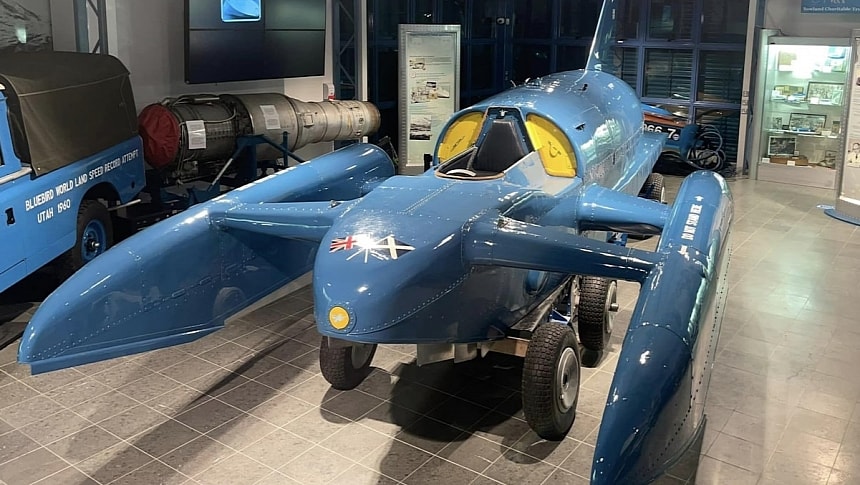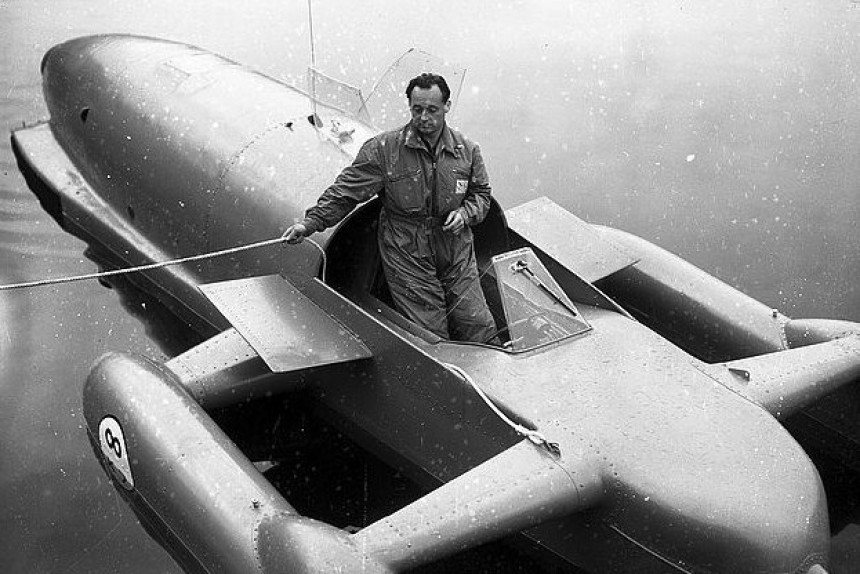The Bluebird K7, the world's first successful jet-engined hydroplane and a multiple-record holder for speed on water, is back at home in Coniston, Cumbria, in the UK. Its road back home was long, perilous, and filled with obstacles, but things are looking up again for this old legend.
Bluebird K7 was speedster Donald Campbell's hydroplane and the vehicle with which he set four world speed records at Coniston Water. Campbell died on the fifth Coniston record attempt, on January 4, 1967, as he pushed the hydroplane faster, believing that a new, more powerful, and lighter engine would help him top his older performance.
He was right about that, but the increase in speed also broke the hydroplane apart. Bluebird, which was also known as Blue Lobster due to its three planing points, hit 320 mph (510 kph) and became airborne, breaking apart and then crashing into the water. Campbell was killed immediately: his body was retrieved from the water, but his beloved Bluebird would spend decades more at the bottom of the lake.
The Bluebird was recovered in 2001 and, by 2018, had already been restored and made to run again. Engineer Bill Smith, who played a significant role in its recovery and restoration, claimed ownership of the hydroplane against the wishes (and birthright) of Campbell's daughter. The ensuing legal battle kept Bluebird largely out of the public eye, as both parties argued they were entitled to it.
This changed last weekend. On Saturday (March 9), Bluebird made its way to Ruskin Museum in Coniston, which had long built a Campbell wing for it. The entire museum is dedicated to the life and achievements of the daredevil, but the Bluebird was meant to occupy a very special place.
It does now: the hydroplane has been moved in its special wing, where it joins Campbell's old Land Rover, The Lady. The Campbell wing will soon be open to the public.
But that's not even the good news. That would be that the museum plans to apply to local authorities to get permission to run the Bluebird again. Initially powered by a Metropolitan-Vickers Beryl axial-flow turbojet engine that made 3,500 pound-force (16 kN) of thrust, the hydroplane went down with a Bristol Siddeley Orpheus engine generating 4,500 pound-force (20 kN) of thrust, which Campbell had gotten it on as a loan from the Ministry of Defense.
It is believed that Smith kept the engine that he'd used on the demo run in 2018, and the Ruskin Museum isn't saying whether they have a certain replacement in mind. But they are determined to get Bluebird running again, adding that "It's not something that will happen overnight but it will be done."
Needless to say, running doesn't mean competing. Given its complicated story and historical significance, it's probably safe to assume that Bluebird K7 is done setting world records. Before the Coniston crash, the last record Campbell set in the Bluebird was in 1964 at Lake Dumbleyung: 276.33 mph (444.71 kph).
He was right about that, but the increase in speed also broke the hydroplane apart. Bluebird, which was also known as Blue Lobster due to its three planing points, hit 320 mph (510 kph) and became airborne, breaking apart and then crashing into the water. Campbell was killed immediately: his body was retrieved from the water, but his beloved Bluebird would spend decades more at the bottom of the lake.
The Bluebird was recovered in 2001 and, by 2018, had already been restored and made to run again. Engineer Bill Smith, who played a significant role in its recovery and restoration, claimed ownership of the hydroplane against the wishes (and birthright) of Campbell's daughter. The ensuing legal battle kept Bluebird largely out of the public eye, as both parties argued they were entitled to it.
It does now: the hydroplane has been moved in its special wing, where it joins Campbell's old Land Rover, The Lady. The Campbell wing will soon be open to the public.
But that's not even the good news. That would be that the museum plans to apply to local authorities to get permission to run the Bluebird again. Initially powered by a Metropolitan-Vickers Beryl axial-flow turbojet engine that made 3,500 pound-force (16 kN) of thrust, the hydroplane went down with a Bristol Siddeley Orpheus engine generating 4,500 pound-force (20 kN) of thrust, which Campbell had gotten it on as a loan from the Ministry of Defense.
It is believed that Smith kept the engine that he'd used on the demo run in 2018, and the Ruskin Museum isn't saying whether they have a certain replacement in mind. But they are determined to get Bluebird running again, adding that "It's not something that will happen overnight but it will be done."
Needless to say, running doesn't mean competing. Given its complicated story and historical significance, it's probably safe to assume that Bluebird K7 is done setting world records. Before the Coniston crash, the last record Campbell set in the Bluebird was in 1964 at Lake Dumbleyung: 276.33 mph (444.71 kph).


